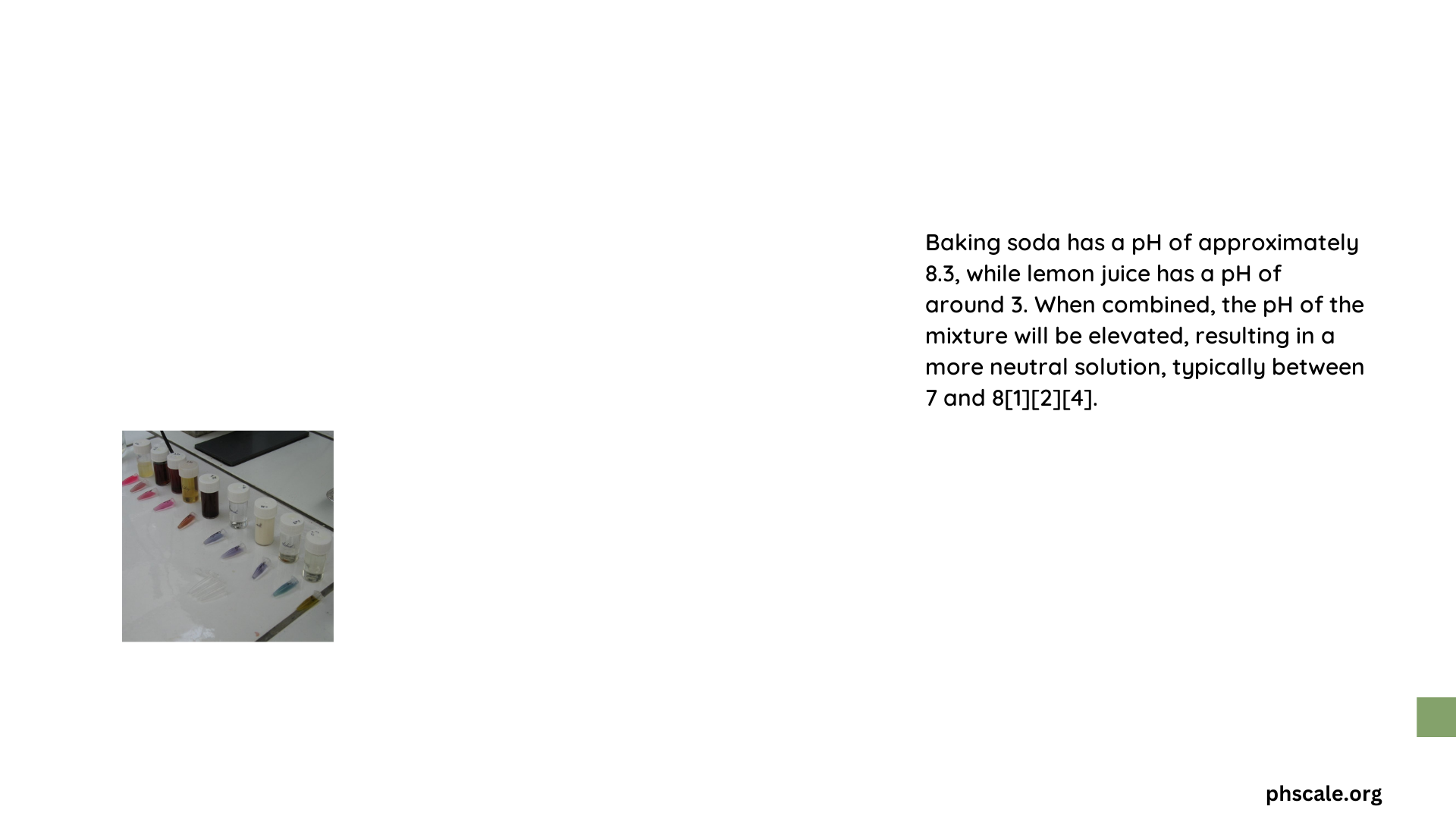The combination of baking soda and lemon juice creates a fascinating chemical reaction that alters the pH level of both substances. When mixed, the alkaline baking soda (sodium bicarbonate) with a pH around 9 reacts with the acidic lemon juice (pH 2-3) to form a more neutral solution. This reaction produces carbon dioxide gas, visible as effervescence, and results in a final pH closer to neutral. The exact pH depends on the proportions used, but it typically falls between 6 and 7 on the pH scale.
What is the pH Scale and How Does it Relate to Baking Soda and Lemon Juice?
The pH scale is a logarithmic measure of the acidity or basicity of a solution, ranging from 0 (most acidic) to 14 (most basic). A pH of 7 is considered neutral. Baking soda, with its pH of around 9, is alkaline, while lemon juice, with a pH between 2 and 3, is acidic. When these substances are combined, their pH levels interact, resulting in a neutralization reaction.
Here’s a breakdown of the pH levels:
| Substance | pH Level |
|---|---|
| Baking Soda | ~9 |
| Lemon Juice | 2-3 |
| Water (neutral) | 7 |
| Mixture of Baking Soda and Lemon Juice | ~6-7 (depending on proportions) |
What Chemical Reaction Occurs When Baking Soda and Lemon Juice Mix?

When baking soda (sodium bicarbonate, NaHCO₃) and lemon juice (containing citric acid, C₆H₈O₇) are combined, a neutralization reaction takes place. This reaction can be represented by the following chemical equation:
NaHCO₃ + C₆H₈O₇ → NaC₆H₅O₇ + H₂O + CO₂
In this reaction:
– Sodium bicarbonate reacts with citric acid
– The products are sodium citrate, water, and carbon dioxide
– The release of CO₂ causes the characteristic fizzing or effervescence
How Does the Neutralization Process Affect the Final pH?
The neutralization process between baking soda and lemon juice significantly impacts the final pH of the mixture. Here’s how it works:
- Initial pH levels:
- Baking soda: ~9 (alkaline)
-
Lemon juice: 2-3 (acidic)
-
Reaction process:
- The alkaline baking soda neutralizes the acidic lemon juice
-
CO₂ is released as a byproduct, causing effervescence
-
Final pH:
- The resulting solution has a pH closer to neutral (around 6-7)
- Exact pH depends on the proportions of baking soda and lemon juice used
This neutralization demonstrates the principle of acid-base reactions and their effect on pH levels.
What Factors Influence the Final pH of the Baking Soda and Lemon Juice Mixture?
Several factors can affect the final pH of the baking soda and lemon juice mixture:
- Proportion of ingredients:
- More baking soda results in a more alkaline final solution
-
More lemon juice leads to a more acidic final solution
-
Concentration of citric acid in lemon juice:
-
Varies between lemons and can affect the acidity of the mixture
-
Purity of baking soda:
-
Impurities can slightly alter its alkalinity
-
Temperature:
-
Higher temperatures can accelerate the reaction and potentially affect the final pH
-
Presence of other substances:
- Additional ingredients or contaminants can influence the pH
Understanding these factors is crucial for predicting and controlling the final pH of the mixture.
How Can You Measure the pH of Baking Soda and Lemon Juice Mixture?
Measuring the pH of a baking soda and lemon juice mixture can be done using several methods:
- pH strips or litmus paper:
- Dip the strip into the mixture
- Compare the resulting color to a pH chart
-
Quick and easy, but less precise
-
Digital pH meter:
- Calibrate the meter according to manufacturer instructions
- Immerse the probe in the mixture
- Read the digital display for a precise pH value
-
More accurate than pH strips
-
Indicator solutions:
- Add a few drops of universal indicator to the mixture
- Compare the color change to a pH chart
- Provides a visual representation of pH
When measuring, consider these tips:
– Wait for the initial reaction to subside to get a stable reading
– Ensure all measuring tools are clean and calibrated
– Take multiple readings for accuracy
What Are the Practical Applications of Understanding Baking Soda and Lemon Juice pH Levels?
Understanding the pH interaction between baking soda and lemon juice has several practical applications:
- Cooking and Baking:
- Leavening in baked goods
- Adjusting acidity in recipes
-
Tenderizing meat
-
Cleaning:
- Natural, non-toxic cleaning solutions
-
Removing stains and odors
-
Personal Care:
- Teeth whitening
- Skin exfoliation
-
Hair care treatments
-
Science Education:
- Demonstrating acid-base reactions
- Teaching pH concepts
-
Introducing chemical equations
-
Home Remedies:
- Alleviating indigestion
- Soothing insect bites
-
Balancing body pH (with caution and medical advice)
-
Environmental Applications:
- Neutralizing soil pH
- Treating wastewater
Understanding these pH interactions allows for safer and more effective use in various applications.
How Does the Baking Soda and Lemon Juice Reaction Compare to Other Common Household pH Reactions?
The baking soda and lemon juice reaction is just one of many pH-altering reactions that occur with common household items. Here’s a comparison:
- Vinegar and Baking Soda:
- Similar to lemon juice and baking soda
- Produces sodium acetate, water, and CO₂
-
Final pH typically around 7
-
Milk of Magnesia and Orange Juice:
- Antacid (basic) reacts with acidic juice
-
Neutralizes stomach acid in a similar manner
-
Soap and Water:
- Soap is slightly basic (pH 9-10)
-
When mixed with water, maintains a mildly basic pH
-
Bleach and Water:
- Bleach is highly basic (pH 11-13)
-
Diluting with water slightly lowers pH but remains basic
-
Coffee and Cream:
- Coffee is acidic (pH 4.5-5)
- Adding cream slightly raises pH
Understanding these comparisons helps in recognizing the ubiquity of pH reactions in everyday life and their practical applications.
What Safety Precautions Should Be Taken When Experimenting with Baking Soda and Lemon Juice pH Levels?
While baking soda and lemon juice are generally safe household items, it’s important to take precautions when experimenting with their pH levels:
- Protective Equipment:
- Wear safety goggles to protect eyes from splashes
-
Use gloves to prevent skin irritation
-
Ventilation:
-
Work in a well-ventilated area to avoid inhaling CO₂
-
Proper Mixing:
- Add ingredients slowly to prevent overflow from rapid reactions
-
Use appropriate containers that won’t react with the mixture
-
Disposal:
- Safely dispose of the mixture down the drain with plenty of water
-
Don’t store the mixed solution for long periods
-
First Aid:
- Have water available to rinse eyes or skin if contact occurs
-
Know basic first aid for chemical exposure
-
Supervision:
-
Adult supervision is necessary for children’s experiments
-
Chemical Purity:
- Use food-grade baking soda and fresh lemon juice
- Avoid contaminated or industrial-grade chemicals
By following these precautions, you can safely explore the fascinating world of pH reactions with baking soda and lemon juice.
